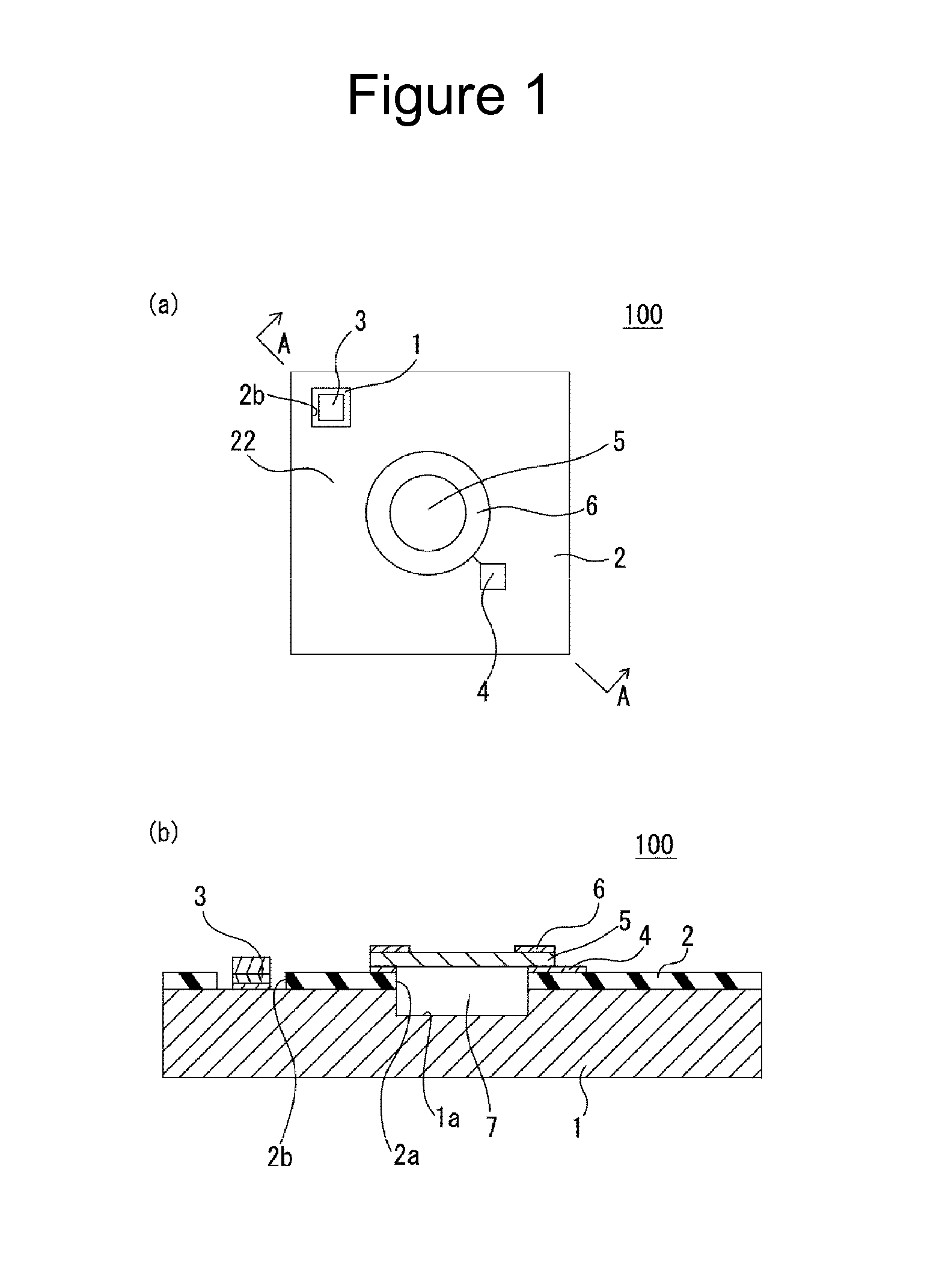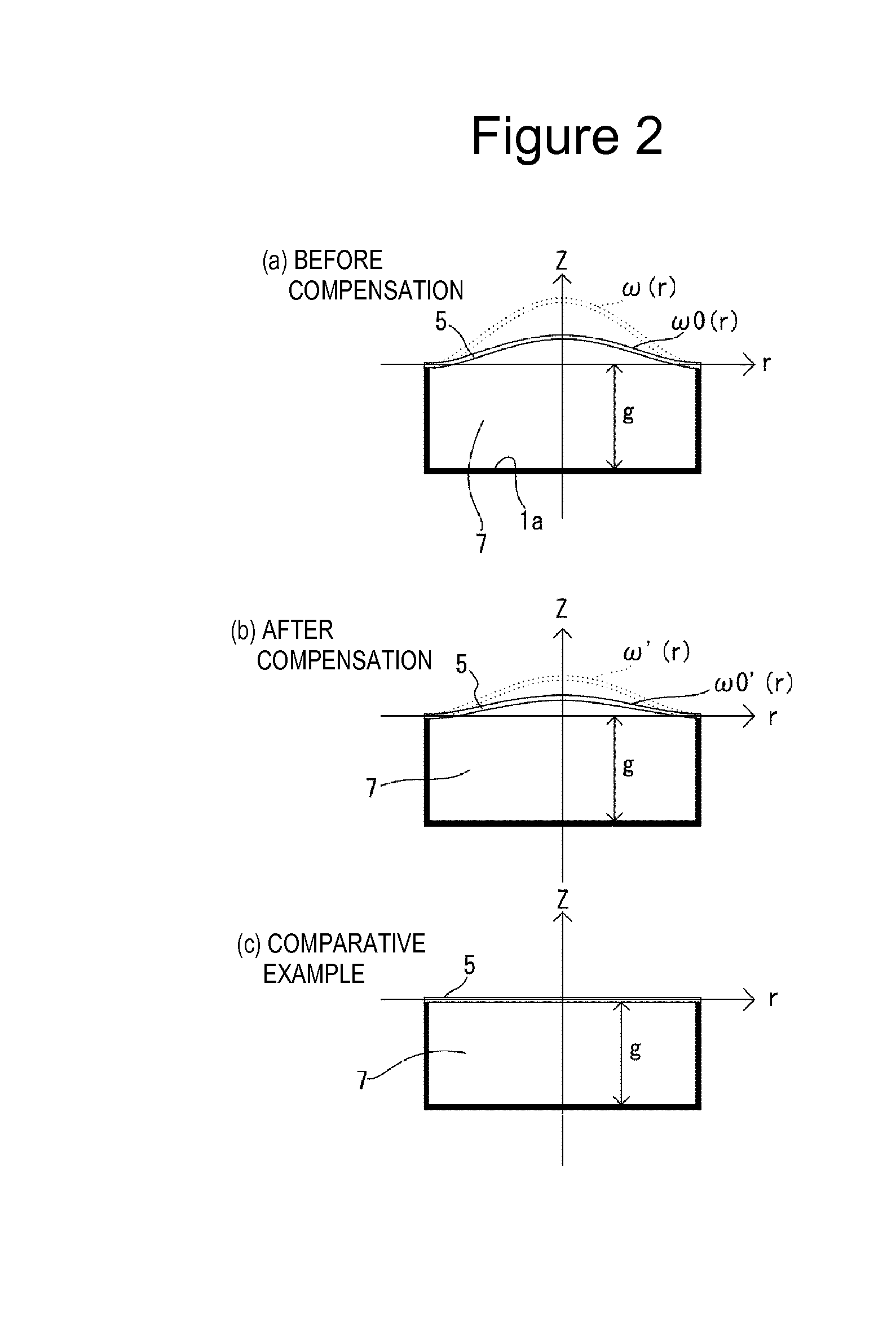Method for temperature compensation in sensor, computation program for method for temperature compensation, computation processing device, and sensor
a technology of temperature compensation and sensor, applied in the direction of liquid/fluent solid measurement, machines/engines, instruments, etc., can solve the problem of disadvantageous difficulty in using a thinner diaphragm to increase pressure sensitivity, and achieve the effect of preventing gas leakage in the closed space and reliability of electric connection
- Summary
- Abstract
- Description
- Claims
- Application Information
AI Technical Summary
Benefits of technology
Problems solved by technology
Method used
Image
Examples
first embodiment
[0072]A method for temperature compensation in a sensor according to a first embodiment of the present invention will be described below with reference to FIG. 1 to FIG. 6.
[0073](Configuration of a Capacitive Sensor 100)
[0074]As shown in FIG. 1(a) and FIG. 1(b), a capacitive sensor (a sensor) 100 to which the results of computations in a method for temperature compensation in the capacitive sensor are applied includes a substrate 1, an insulator layer 2, a first electrode portion 3, a second electrode portion (conductive portion) 4, a diaphragm portion 5, a temperature compensation ring (temperature compensation member) 6, and a closed space 7.
[0075]The substrate 1 is formed of a semiconductor such as silicon and has a circular recess 1a in a substantially central portion of the substrate 1.
[0076]The insulator layer 2 is a layer formed of an insulator such as silicon dioxide and is formed on one surface of the substrate 1. The insulator layer 2 also has a circular penetration portio...
second embodiment
[0113]Now, a method for temperature compensation in a sensor according to a second embodiment of the present invention will be described with reference to FIG. 7 to FIG. 10. Portions 21 to 27 (some of the portions are not shown in the drawings) of a capacitive sensor 200 to which the results of computations in the method for temperature compensation according to the second embodiment are applied are similar to the portions 1 to 7, respectively, of the capacitive sensor 100 to which the results of computations in the method for temperature compensation according to the first embodiment are applied. Thus, description of the portions 21 to 27 may be omitted.
[0114](Configuration of the Capacitive Sensor 200)
[0115]As shown in FIG. 7, the capacitive sensor (the sensor) 200 includes a substrate 21, an insulator layer 22, a first electrode portion 23, a second electrode portion (conductive portion) 24, a diaphragm portion 25, a temperature compensation ring (temperature compensation member)...
third embodiment
[0122]Now, a method for temperature compensation in a sensor according to a third embodiment of the present invention will be described with reference to FIG. 11 to FIG. 14. Portions 31 to 37 (some of the portions are not shown in the drawings) of a capacitive sensor 300 to which the results of computations in the method for temperature compensation according to the third embodiment are applied are similar to the portions 1 to 7, respectively, of the capacitive sensor 100 to which the results of computations in the method for temperature compensation according to the first embodiment are applied. Thus, description of the portions 31 to 37 may be omitted.
[0123](Configuration of the Capacitive Sensor 300)
[0124]As shown in FIG. 11, the capacitive sensor (the sensor) 300 includes a substrate 31, an insulator layer 32, a first electrode portion 33, a second electrode portion 34, a diaphragm portion 35, a temperature compensation ring (temperature compensation member) 36, and a closed spa...
PUM
| Property | Measurement | Unit |
|---|---|---|
| pressure sensitivity | aaaaa | aaaaa |
| pressure | aaaaa | aaaaa |
| inner diameter | aaaaa | aaaaa |
Abstract
Description
Claims
Application Information
 Login to View More
Login to View More - R&D
- Intellectual Property
- Life Sciences
- Materials
- Tech Scout
- Unparalleled Data Quality
- Higher Quality Content
- 60% Fewer Hallucinations
Browse by: Latest US Patents, China's latest patents, Technical Efficacy Thesaurus, Application Domain, Technology Topic, Popular Technical Reports.
© 2025 PatSnap. All rights reserved.Legal|Privacy policy|Modern Slavery Act Transparency Statement|Sitemap|About US| Contact US: help@patsnap.com



